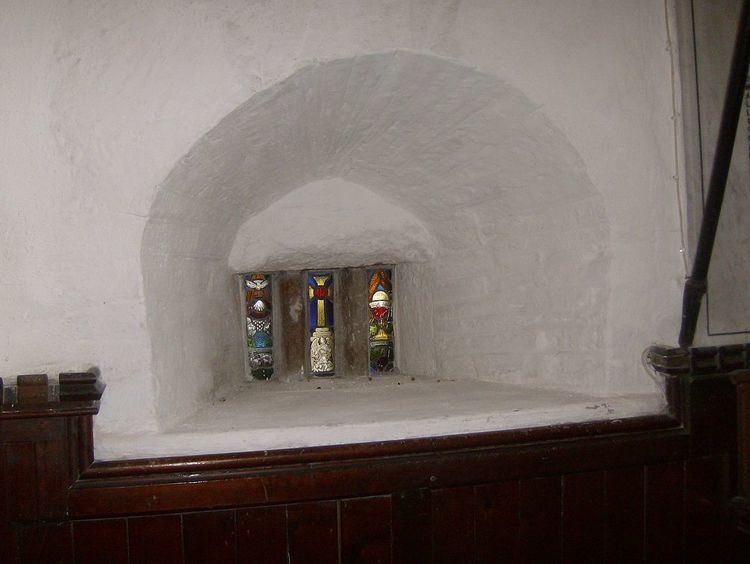 | ||
A hagioscope (from Gr. άγιος, holy, and σκοπεῖν, to see) or squint, in architecture, is an opening through the wall of a church in an oblique direction, to enable the worshippers in the transepts or other parts of the church, from which the altar was not visible, to see the elevation of the host. They were also sometimes known as "leper windows" wherein a squint was made in an external wall so that lepers and other non-desirables could see the service without coming into contact with the rest of the populace.
Contents
Function
In medieval architecture hagioscopes were often a low window in the chancel wall and were frequently protected by either a wooden shutter or iron bars. Hagioscopes are found on one or both sides of the chancel arch; in some cases a series of openings has been cut in the walls in an oblique line to enable a person standing in the porch (as in Bridgwater church, Somerset) to see the altar; in this case and in other instances such openings were sometimes provided for an attendant, who had to ring the Sanctus bell when the Host was elevated.
Though rarely encountered in continental Europe, they are occasionally found to serve such purposes as allowing a monk in one of the vestries to follow the service and to communicate with the bell-ringers. Sometimes squints were placed to enable nuns to observe the services without having to give up their isolation. The unusual design of the church of St Helen's in Bishopsgate, one of the largest surviving ancient churches of London, arose from its once having been two separate places of worship: a 13th-century parish church and the chapel of a Benedictine convent. On the convent side of the church a "squint" allowed the nuns to observe the parish masses; church records show that the squint in this case was not enough to satisfy the nuns, who were eventually admonished to "abstain from kissing secular persons," a habit to which it seems they had become "too prone".
Finland
There is only one hagioscope in Finland, in Olavinlinna castle (St. Olaf's Castle), in the town of Savonlinna.
France
In France the hagioscope of Notre Dame in Dives-sur-Mer, Normandy, has the inscription trou aux lépreux (leper window). Other hagioscopes are known at St. Laurent in Deauville, Normandy and at the old church of St. Maurice in Freyming-Merlebach, Lorraine.
Germany
In Germany a number of hagioscopes still exist or were rediscovered in the 19th and 20th century. They are found mainly in Lower Saxony which had a small population in the Middle Ages and only a few bigger cities. In cities lepers lived together in housing estates which often had their own chapels. In Georgsmarienhütte the hagioscope of church St. Johann belonged to the former Benedictine convent Kloster Oesede, founded in the 12th century and reconstructed in the early 1980s. Nearby in Bad Iburg a hagioscope was rediscovered at St. Clemens, church of former Benedictine monastery in the castle and monastery complex Schloss Iburg. Other hagioscopes in Lower Saxony are found in Bokelesch, Westoverledingen, Dornum, Midlum, Kirchwahlingen (Gemeinde Böhme) and Hankensbüttel.
In Northrhine-Westphalia St. Antonius-Kapelle in Gescher-Tungerloh-Capellen has a hagioscope. St. Antonius is used as Autobahn chapel at Bundesautobahn 31. Another hagioscope is found in St. Ulricus in Börninghausen. In Rhineland-Palatinate the church of St. Eligius-Hospital in Neuerburg has a hagioscope. In Baden-Württemberg there is a hagioscope in St. Peter und Paul, the Old Cemetery Church of Nusplingen.
Ireland
Netherlands
St. Vitus in Wetsens, and Jistrum, both in Friesland, have hagioscopes, as does the oldest church in the Netherlands, which stands in Oosterbeek.
Sweden
In Sweden Bro church near Visby on Gotland has a cross-shaped hagioscope. Other hagioscopes are at the church of Vreta Abbey near Linköping, Granhult Kyrka in Uppvidinge and Husaby Kyrka in Götene. The wooden church in Granhult (Småland) has a hagioscope which can be closed.
United Kingdom
Churches in England with hagioscopes include:
At St Bees Priory a purpose-built squint was included in the wall of the 14th-century chapel to give a view of the high altar. The window was low enough to allow a person to kneel whilst looking through the aperture. The hagioscope at St Mary the Virgin, Lytchett Matravers, is unusually large; although unknown in origin it provides a view to the communion table from the 16th-century north aisle. It is large enough that it is often used as a corridor for access to the chancel.
